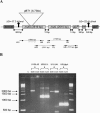Role of mutS and mutL genes in hypermutability and recombination in Staphylococcus aureus
- PMID: 15866932
- PMCID: PMC1112015
- DOI: 10.1128/JB.187.10.3455-3464.2005
Role of mutS and mutL genes in hypermutability and recombination in Staphylococcus aureus
Abstract
The mutator phenotype has been linked in several bacterial genera to a defect in the methyl-mismatch repair system, in which the major components are MutS and MutL. This system is involved both in mismatch repair and in prevention of recombination between homeologous fragments in Escherichia coli and has been shown to play an important role in the adaptation of bacterial populations in changing and stressful environments. In this report we describe the molecular analysis of the mutS and mutL genes of Staphylococcus aureus. A genetic analysis of the mutSL region was performed in S. aureus RN4220. Reverse transcriptase PCR experiments confirmed the operon structure already reported in other gram-positive organisms. Insertional inactivation of mutS and mutL genes and complementation showed the role of both genes in hypermutability in this species. We also designed an in vitro model to study the role of MutS and MutL in homeologous recombination in S. aureus. For this purpose, we constructed a bank of S. aureus RN4220 and mutS and mutL mutants containing the integrative thermosensitive vector pBT1 in which fragments with various levels of identity (74% to 100%) to the S. aureus sodA gene were cloned. MutS and MutL proteins seemed to have a limited effect on the control of homeologous recombination. Sequence of mutS and mutL genes was analyzed in 11 hypermutable S. aureus clinical isolates. In four of five isolates with mutated or deleted mutS or mutL genes, a relationship between alterations and mutator phenotypes could be established by negative complementation of the mutS or mutL mutants.
Figures



Similar articles
-
The mismatch repair system (mutS, mutL and uvrD genes) in Pseudomonas aeruginosa: molecular characterization of naturally occurring mutants.Mol Microbiol. 2002 Mar;43(6):1641-50. doi: 10.1046/j.1365-2958.2002.02855.x. Mol Microbiol. 2002. PMID: 11952911
-
In vitro and in vivo studies of MutS, MutL and MutH mutants: correlation of mismatch repair and DNA recombination.DNA Repair (Amst). 2003 Apr 2;2(4):387-405. doi: 10.1016/s1568-7864(02)00245-8. DNA Repair (Amst). 2003. PMID: 12606120
-
Insertional inactivation of mutS in Staphylococcus aureus reveals potential for elevated mutation frequencies, although the prevalence of mutators in clinical isolates is low.J Antimicrob Chemother. 2002 Aug;50(2):161-9. doi: 10.1093/jac/dkf118. J Antimicrob Chemother. 2002. PMID: 12161395
-
[Homologs of MutS and MutL during mammalian meiosis].Med Sci (Paris). 2003 Jan;19(1):85-91. doi: 10.1051/medsci/200319185. Med Sci (Paris). 2003. PMID: 12836196 Review. French.
-
Structure and function of mismatch repair proteins.Mutat Res. 2000 Aug 30;460(3-4):245-56. doi: 10.1016/s0921-8777(00)00030-6. Mutat Res. 2000. PMID: 10946232 Review.
Cited by
-
Effects of subinhibitory concentrations of antibiotics on SOS and DNA repair gene expression in Staphylococcus aureus.Antimicrob Agents Chemother. 2008 Sep;52(9):3394-7. doi: 10.1128/AAC.01599-07. Epub 2008 Jun 30. Antimicrob Agents Chemother. 2008. PMID: 18591271 Free PMC article.
-
Genomic epidemiology of Staphylococcus aureus isolated from bloodstream infections in South America during 2019 supports regional surveillance.Microb Genom. 2023 May;9(5):mgen001020. doi: 10.1099/mgen.0.001020. Microb Genom. 2023. PMID: 37227244 Free PMC article.
-
Adaptive evolution of Staphylococcus aureus during chronic endobronchial infection of a cystic fibrosis patient.PLoS One. 2011;6(9):e24301. doi: 10.1371/journal.pone.0024301. Epub 2011 Sep 2. PLoS One. 2011. PMID: 21912685 Free PMC article.
-
A pilot study of rapid benchtop sequencing of Staphylococcus aureus and Clostridium difficile for outbreak detection and surveillance.BMJ Open. 2012 Jun 6;2(3):e001124. doi: 10.1136/bmjopen-2012-001124. Print 2012. BMJ Open. 2012. PMID: 22674929 Free PMC article.
-
Staphylococci: Evolving Genomes.Microbiol Spectr. 2019 Nov;7(6):10.1128/microbiolspec.gpp3-0071-2019. doi: 10.1128/microbiolspec.GPP3-0071-2019. Microbiol Spectr. 2019. PMID: 31845645 Free PMC article. Review.
References
-
- Ban, C., M. Junop, and W. Yang. 1999. Transformation of MutL by ATP binding and hydrolysis: a switch in DNA mismatch repair. Cell 97:85-97. - PubMed
-
- Ban, C., and W. Yang. 1998. Crystal structure and ATPase activity of MutL: implications for DNA repair and mutagenesis. Cell 95:541-552. - PubMed
-
- Bruckner, R. 1997. Gene replacement in Staphylococcus carnosus and Staphylococcus xylosus. FEMS Microbiol. Lett. 151:1-8. - PubMed
-
- Cuny, C., and W. Witte. 2000. In vitro activity of linezolid against staphylococci. Clin. Microbiol. Infect. 6:331-333. - PubMed
Publication types
MeSH terms
Substances
LinkOut - more resources
Full Text Sources
Molecular Biology Databases

